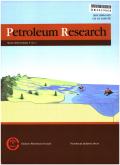UVA光下磁性污泥处理含油有毒石油废水的创新研究
IF 4
Q1 Earth and Planetary Sciences
引用次数: 0
摘要
本研究的主要目的是解决管理各种工业过程中产生的大量有毒油泥和油废物的关键问题。这一环境挑战对生态系统和人类健康构成重大风险,需要采取有效的补救战略。在这项研究中,我们开创性地尝试合成一种新型光催化剂,特别是基于Char/Fe3O4/ tio2的磁性蜡质柴油污泥,旨在减少有毒含油石油废水在紫外线照射下存在的复杂和有害化合物。Char/Fe3O4/TiO2光催化剂的合成采用了一种创新的方法,将二氧化钛(TiO2)精心涂覆在专门制备的合成磁性活性炭上。采用一系列分析技术证实了光催化剂的成功合成。这些分析包括傅里叶变换红外光谱、高分辨率透射电子显微镜、能量色散x射线光谱、x射线衍射、布鲁诺尔-埃米特-泰勒表面积分析、热重分析与差分热重分析相结合、CHNOS分析、x射线荧光、拉曼光谱、漫反射光谱和振动样品磁强计技术。这些不同分析方法的使用为合成光催化剂的结构和功能完整性提供了有力的证据。实验工作在受控的间歇系统中进行,以评估不同条件下光催化剂的有效性。从分析中获得的结果证实了铁和二氧化钛在合成的磁性炭中的成功掺入,从而验证了光催化剂的合成。为进一步优化废水处理工艺,采用响应面法系统考察了各操作参数对废水处理工艺的影响。确定了处理有毒含油石油废水的最佳条件为:pH为6.5,光催化剂用量为300 mg,温度为35℃,UVA6W照射下照射时间为35 min。在此理想条件下,光催化系统对有害化合物的去除率为98.136%,生化需氧量去除率为95.194%,总凯氏定氮去除率为92.66%,总溶解固体去除率为95.99%,总悬浮物去除率为91.99%。动力学和等温线研究进一步阐明了光催化过程的行为,表明Char/Fe3O4/TiO2对有毒含油废水的去除符合准一级动力学模型,以及Freundlich和Henderson等温线模型。负的标准活化焓(ΔHo)表明吸附过程是放热的,表明在去除过程中释放了热量。相反,标准吉布斯活化自由能(ΔGo)随温度的升高表明吸附是一个非自发过程,而标准活化熵(ΔSo)的负值表明反应物演化成活化配合物时的自由度降低。总之,从磁性污泥中开发和部署设计良好的创新光催化剂是一种具有成本效益的石油废水修复策略。这种方法不仅为寻求减轻环境足迹的工业制造商带来了希望,而且也是朝着改善环境质量和可持续性迈出的重要一步。本文章由计算机程序翻译,如有差异,请以英文原文为准。

Innovative treatment of toxic oily petroleum wastewater with magnetic sludge under UVA light
The primary objective of the present study is to address the critical issue of managing the large volumes of toxic oil sludge and oil waste generated in various industrial processes. This environmental challenge poses significant risks to ecosystems and human health, necessitating effective remediation strategies. In this research, we make a pioneering attempt to synthesize a novel photocatalyst, specifically Char/Fe3O4/TiO2-based magnetic waxy diesel sludge, aimed at reducing the complex and hazardous compounds present in toxic oily petroleum wastewater when exposed to ultraviolet light. The synthesis of the Char/Fe3O4/TiO2 photocatalyst involved an innovative approach where titanium dioxide (TiO2) was meticulously coated onto specially prepared synthetic magnetic activated carbon. A comprehensive array of analytical techniques was employed to substantiate the successful synthesis of the photocatalyst. These analyses included Fourier-transform infrared spectroscopy, high-resolution transmission electron microscopy, energy-dispersive X-ray spectroscopy, X-ray diffraction, Brunauer–Emmett–Teller surface area analysis, thermogravimetric analysis combined with differential thermogravimetry, CHNOS analysis, X-ray fluorescence, Raman spectroscopy, diffuse reflectance spectroscopy, and vibrating sample magnetometer techniques. The utilization of these diverse analytical methods provides robust evidence of the structural and functional integrity of the synthesized photocatalyst. The experimental work was conducted in a controlled batch system to evaluate the effectiveness of the photocatalyst under varying conditions. The results obtained from the analyses confirmed the successful incorporation of iron and titanium dioxide within the synthesized magnetic char, thereby validating the synthesis of the photocatalyst. To further optimize the wastewater treatment process, Response Surface Methodology was employed to systematically investigate the influence of various operational parameters. The optimal conditions for the treatment of toxic oily petroleum wastewater were determined to be at a pH of 6.5, with a photocatalyst dosage of 300 mg, a temperature of 35 °C, and an exposure time of 35 min under UVA6W irradiation. Under these ideal conditions, the photocatalytic system demonstrated remarkable efficacy in removing hazardous compounds, achieving removal rates of 98.136% for Chemical Oxygen Demand, 95.194% for Biochemical Oxygen Demand, 92.66% for Total Kjeldahl Nitrogen, 95.99% for Total Dissolved Solids, and 91.99% for Total Suspended Solids. Kinetic and isotherm studies further elucidated the behavior of the photocatalytic process, revealing that the removal of toxic oily wastewater with Char/Fe3O4/TiO2 adhered closely to pseudo-first-order kinetic models, as well as the Freundlich and Henderson isotherm models. The negative standard enthalpy of activation (ΔHo) indicated that the adsorption process is exothermic, suggesting that heat is released during the removal process. Conversely, the increasing value of the standard Gibbs free energy of activation (ΔGo) with temperature signified that the adsorption is a nonspontaneous process, while the negative value of the standard entropy of activation (ΔSo) implied a reduction in the degree of freedom of the reactants as they evolve into the activated complex. In conclusion, the development and deployment of a well-designed, innovative photocatalyst from the magnetic sludge (represent a cost-effective strategy for the remediation of petroleum wastewater. This approach not only holds promise for industrial manufacturers seeking to mitigate their environmental footprint but also serves as a significant step toward improving environmental quality and sustainability.
求助全文
通过发布文献求助,成功后即可免费获取论文全文。
去求助
来源期刊

Petroleum Research
Earth and Planetary Sciences-Geology
CiteScore
7.10
自引率
0.00%
发文量
90
审稿时长
35 weeks
 求助内容:
求助内容: 应助结果提醒方式:
应助结果提醒方式:


